Pesticides, Ecology and Environmental Considerations
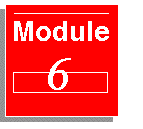
Ecology and Environmental Considerations
The words "environment" and "ecology" have been increasingly in the news. Man is
beginning to fear that his daily activities may be limiting the future use of
resources. Pesticide use and drift can affect air quality; pesticides in the
food chain can threaten wildlife populations; and soil may no longer be suitable
for optimal crop production. Pesticides are now recognized to be non-point
sources of water pollution. As a result, pesticide practices are being watched
closely. As pesticide applicators, it is important to do your job carefully by
both controlling pest populations and at the same time protecting the
environment from the potential adverse effects of pesticide use.
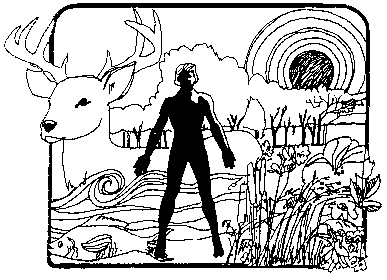
Goals of This Module
- Understand the dangers of pesticides in the environment and what causes them.
- Be familiar with how pesticides pollute groundwater and what steps can be taken
to prevent it.
- Understand how pesticides persist in the environment.
Pesticides In the Environment
The human race needs a place to live with clean air and water, food which is not
harmful, and an environment which will not threaten our health and safety. Since
we share this planet with many other living creatures, we also have an
obligation to protect the earth's resources from degradation. Few people will
argue with the statement that pollution will grow as our planet's population
grows. It is important that sensitivity and awareness of these problems also
grow. Population increases will require more food, fiber, and building materials
and will create an increasing demand on the earth's finite resources. An
additional effect of the population crunch will be an increase in environmental
sensitivity and government regulations to protect the environment from pesticide
pollution.
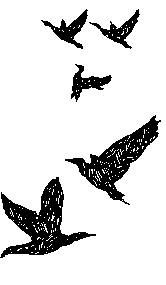 Pesticides enhance public health
and the environment when they are used properly and wisely. For example, they
have been used to control pests which could be harmful to man. Rats carrying
plague or mosquitoes carrying malaria are two good examples. These control
programs are necessary, especially in crowded cities and countries with large
numbers of people. However, pesticides can also harm public health and the
environment. Any pesticide which is off-target is a pollutant and can be
dangerous. The benefits of pesticide use are meaningless if pollution occurs
through misuse and/or carelessness.
Pesticides enhance public health
and the environment when they are used properly and wisely. For example, they
have been used to control pests which could be harmful to man. Rats carrying
plague or mosquitoes carrying malaria are two good examples. These control
programs are necessary, especially in crowded cities and countries with large
numbers of people. However, pesticides can also harm public health and the
environment. Any pesticide which is off-target is a pollutant and can be
dangerous. The benefits of pesticide use are meaningless if pollution occurs
through misuse and/or carelessness.
Air and Pesticides
Air must be available for plants and animals to live. It is a source of oxygen
for breathing as well as receiving carbon dioxide waste. Air has the ability to
move particles for long distances. Most of the time this ability aids mankind.
It causes rain, for example. Unfortunately, for the pesticide applicator this
same ability is the cause of drift. Pesticide drift is the physical movement of
a pesticide through the air at the time of pesticide application, or soon
thereafter, from the target site to any non- or off-target site. Pesticides in
the air are not controllable and may settle into waterways, homes, lawns, wooded
areas, etc. Drift must be avoided.
 Would you like to try a study question?
Would you like to try a study question?
Controlling drift is important for the commercial applicator as well as the
private applicator. To be effective, the pesticide must be applied precisely on
target at the correct rate, volume, and pressure. Drift from the target area may
injure people, pets, wildlife, and sensitive plants. Drift of herbicides can
damage nearby crops, forests, or landscape plantings. Poorly timed applications
can kill bees and other pollinators which are working in the area. Beneficial
parasites and predators that help control pests may also be killed. Drift can
also be a problem indoors. Pest control operators must be aware that forced air
heating systems and air conditioning units can move sloppily applied pesticides.
 Would you like to try a study question?
Would you like to try a study question?
 Would you like to try a study question?
Would you like to try a study question?
Particle Drift. Particle drift is influenced by many factors. Particle
size, nozzle design and orientation, pressure, temperature, humidity,
evaporation, height of release, air velocity and movement are among several
important considerations.
Particle and droplet size. The smaller the particle size, the greater the
potential for drift. Dust formulations are made of small particles and have a
greater potential for drift than granular formulations. Small liquid droplets,
especially those under 100 microns, also tend to drift more than large droplets.
Whenever practical the applicator should use the largest droplet size in
obtaining effective pest control.
Nozzle type, orientation and size. In terms of liquid drift control, the
nozzle is probably more important than pressure. All nozzles produce a range of
droplet sizes. Nozzles which produce small (fine) droplets should be avoided.
Nozzles which produce small (fine) droplets should be avoided in drift-sensitive
situations. Drift reduction nozzles minimize spray drift and should be used for
applications in drift-sensitive situations. Placement of the nozzle in the air
stream, especially where airblast and aerial application equipment are
concerned, also affect droplet size. Nozzles pointed across the air flow produce
smaller droplets. This is caused by wind shear.
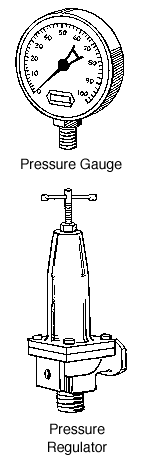 Pressure. Droplet size
is influenced by pressure. Some equipment operators will correct drift by
varying pressure. The higher the pressure, the smaller the droplet. With smaller
droplets better coverage may be gained resulting in higher chemical performance
but at the expense of drift control. Because larger droplets are heavier and
more difficult to move off target, reducing the pressure will help control
drift.
Pressure. Droplet size
is influenced by pressure. Some equipment operators will correct drift by
varying pressure. The higher the pressure, the smaller the droplet. With smaller
droplets better coverage may be gained resulting in higher chemical performance
but at the expense of drift control. Because larger droplets are heavier and
more difficult to move off target, reducing the pressure will help control
drift.
 Would you like to try a study question?
Would you like to try a study question?
Height of nozzle. Nozzles positioned too high will disperse spray over a
wider area. This will also increase the likelihood of drift because spray
particles must fall over a greater distance. The applicator must decide the
desired swath width by striking a balance among nozzle spray angle, pressure,
and height above the target. For example, if an operator increases the
application pressure and the rate, but maintains the swath width, he should
lower the nozzle to compensate for the increased pressure. Lowering the nozzle
may require switching to nozzles with a wider spray angle.
Air movement. Both horizontal and vertical air movement can affect drift.
Unless it is calm, most pesticide applications are subjected to constant air
movement. Indoors, heating and air conditioning systems move air and can move
pesticides. Outside, unpredictable changes in this air movement can happen at
any time to cause spray drift. Thus, wind direction and speed directly affect
the direction, amount, and distance of drift.
Temperature and Humidity. The rate of droplet evaporation is determined
to a great degree by temperature and humidity. A droplet that evaporates before
reaching the target does not control pests.
 Would you like to try a study question?
Would you like to try a study question?
Vapor Movement. A pesticide that has vaporized (evaporated) can be
carried from the treated area by air currents. The movement of pesticide vapors
in the atmosphere is called vapor movement. Vapor movement, unlike spray or dust
drift, is related to the chemical properties of the pesticide. Unlike the drift
of sprays and dusts that can sometimes be seen during an application, vapor
movement is not visible. Vapor movement can be caused by vapor leakage.
Fumigants and other volatile materials exert pressure on the environment around
them. Like air in a balloon, they are actively trying to escape. Stopping vapor
leakage from their containers is done by keeping them closed or sealed.
Fumigation sites must also be sealed properly to keep the pesticide from
leaking. Applying these materials with vapor tight equipment is important. Some
herbicides in particular can volatilize and move from a treated area, reducing
control of the target weeds and increasing the likelihood that non-target plants
will be injured. Pesticide vapors inside a dwelling can also cause injury,
particularly if the occupants are sensitive.
 Would you like to try a study question?
Would you like to try a study question?
Application of a volatile pesticide should be avoided when conditions favor
volatilization, such as high temperature. The vapor pressure rating of a
pesticide may help the applicator know the volatility of a pesticide. However,
pesticide labels usually do not have the vapor pressure rating. Labels will give
warning statements that the applicator must be sensitive to. The following are
examples:
- At high air or ground surface temperatures, vapors from this product may injure
susceptible plants.
- Under very high temperatures, vapors from this product may injure susceptible
plants in the immediate vicinity.
- Off- site movement of spray drift or vapors of this product can cause foliar
whitening or yellowing of some plants.
What can be done to avoid drift?
- Apply the largest effective droplet size.
- Use the lowest practical pressure.
- Choose nozzles that produce large numbers of large particles.
- Place nozzles with the air stream and not across it.
- Apply as close as practical to the target.
- Use a drift control additive.
- Do not apply when wind, temperature, or humidity are
unfavorable.
- Choose non-volatile (those that do not vaporize easily) pesticide formulations.
- Increase the flow rates of your application (more gallons per acre).
- Consider establishing buffer zones.
- Consider using new technologies
- drift reduction nozzles
- spray shields
- electrostatic applicators
- air-assist spray equipment
The careful use of pesticides is of prime concern to everyone today. Many
factors interact to influence the distance material will drift from the target
area. Even when common sense and good application technology are followed, drift
can still be a problem for the applicator. Label instructions must be followed
and strict attention must be given to the control of pesticide drift.
Pesticides and Water Resources
Water as a Natural Resource. Water is one of our greatest resources and
is essential for all life. Man needs clean water for drinking, cooking, and
bathing. Clean water is also essential to farmers who must feed livestock and
irrigate crops. Half of the U.S. population and 90% of the rural population rely
on groundwater for their drinking water. Groundwater makes up 96% of the world's
total fresh water resource. Once considered to be safe from pollution,
groundwater is now a threatened natural resource.
Groundwater and the Water Cycle. Groundwater is part of the water cycle.
Groundwater is primarily stored in aquifers; geologic formations of permeable
rock, sand, and gravel that contain enough water to yield usable amounts to
wells and springs. Groundwater may come to the surface naturally at a spring or
it may be drawn to the surface from a well. The cycle begins with precipitation
such as rain or snow. Runoff from this enters surface waters, lakes, streams,
and rivers. Some of this water seeps through the ground where moisture is drawn
up by plant root systems. Water also moves downward through the soil (leaches)
to become part of the groundwater. Water is then returned to the atmosphere
through plant transpiration and evaporation from surface water, thus completing
the water cycle.
 Would you like to try a study question?
Would you like to try a study question?
 Would you like to try a study question?
Would you like to try a study question?
Surface water results from precipitation, runoff, and the exchange of water from
underground aquifers. Small streams flow and become rivers, gaining in water
volume as the flow finds lower points along the waterway. The water gained along
the way is often from a groundwater source. Where groundwater reaches lakes,
streams, rivers or oceans it is released and becomes surface water. Streams can
also lose water into the ground.

How Pesticides Pollute Groundwater.Under certain conditions, contaminants
including soil nutrients, wastes, and chemicals can migrate to groundwater
sources. Pesticides applied correctly to a site may be moved downward with rain
or irrigation water, reaching the water table below. This method of
contamination is called non-point source pollution. Pesticides may enter
a well directly from spillage or back-siphonage, thus entering the groundwater
directly. This is called point source pollution. Because groundwater
moves slowly, contaminants do not spread quickly. After pesticides reach
groundwater they may continue to break down, but at a much slower rate because
of less available light, heat, and oxygen. Thus, they can remain underground in
slow-moving plumes for an indefinite period. When groundwater becomes
contaminated, the polluted water may eventually appear in the surface water
streams, rivers, and lakes. Because of the complex nature of groundwater, when
the contamination is detected it is often widespread. Even if the contamination
is stopped, it may take years before an aquifer can purify itself through
natural processes. Once contaminated, groundwater is difficult and expensive to
clean. Water from this source may be unusable for years. The best protection
against groundwater pollution is prevention.
 Would you like to try a study question?
Would you like to try a study question?
Factors that Affect the Fate of Pesticides in Water.
Various processes affect the fate of pesticides following an application,
disposal, or spill. The two basic processes are those that transfer chemicals or
influence their movement, and those that degrade or break down chemicals. The
primary transfer processes are adsorption, volatilization, runoff, leaching, and
removal of treated crops or animals from an area. The degradation processes are
microbial, chemical, and photodegradation.
Adsorption. Adsorption is the binding of chemicals to other particles.
Pesticide adsorption in soil depends on the pesticide properties, soil moisture
content, soil pH (acidity), and soil texture. Soils high in organic matter or
clay are the most adsorptive, while coarse, sandy soils that lack organic matter
or clay are much less adsorptive.
A soil-adsorbed pesticide is less likely to volatilize, leach, or degrade. When
pesticides are tightly bound to soil particles in highly adsorptive soil, they
are less available for absorption by plants and microorganisms. However, soil
adsorbed pesticides can be lost by erosion. Understanding adsorption factors can
reduce damage to sensitive plants, leaching to groundwater, and the presence of
illegal residues in a food or feed crops.
Volatilization. Volatilization is like evaporation. A solid or liquid can
change its state and turn into a gas or vapor. For example, water left in an
open pan volatilizes (evaporates) into water vapor and disappears. Some
pesticides are very volatile. The volatility of a pesticide depends on its vapor
pressure and temperature. The volatilization of pesticides increases with higher
air temperature and air movement, low relative humidity and when spray droplets
are small.
Runoff. Runoff occurs when water carries pesticides, either mixed in the
water or bound to eroding soil, to off target points. Rain carries pesticides
off plant leaves to foliage near the ground and into the soil. The amount of
pesticide runoff depends on the grade or slope of an area, the erodibility and
texture of the soil, the soil moisture content, the amount and timing of
irrigation or rainfall, and the properties of the pesticide.
Leaching. Leaching is the movement of contaminants, such as water-soluble
pesticides or fertilizers carried by water downward through permeable soils. Several factors influence pesticide leaching. A pesticide that is
easily dissolved in water moves with the water as it seeps through the soil.
Soil structure and texture influence the rate and depth of pesticide leaching.
Sandy and gravel soils have poor adsorption characteristics and allow water and
pesticides to leach through quickly. A heavy clay soil does not allow for rapid
leaching. Adsorption influences pesticide leaching because pesticides that are
strongly adsorbed to soil particles leach less. The Soil Conservation Service is
a good source of information on soil types, characteristics, and geological
formations of your area. Leaching of pesticides from treated areas, mixing and
rinsing sites, waste disposal areas, and manufacturing facilities is a major
ground -water concern.
Groundwater Protection. Most of man's activities change the quality of
the underground water sources. Polluted water typically enters an aquifer in
recharge water originating at the land's surface. Pollution can also be injected
directly into an aquifer, for example, by back-siphoning directly into a well.
To minimize pesticide leaching to groundwater sources, consider the following
steps:
- Read the label for any warnings.
- Evaluate the need, method, and frequency of pesticide use.
- Use alternative pest control methods whenever possible.
- Identify and know the vulnerability of the soil and leaching potential of the
pesticide you are using.
- Consider the location of the pesticide application in relation to groundwater
and surface water. Know the water table depth and the permeability of the
geological layers between the surface and the groundwater. Be cautious around
sinkholes or old wells because surface water easily reaches groundwater from
these conduits.
- Reduce pesticide use and handling close to water wells. Groundwater
contamination by pesticides or other pollutants can enter a well directly from
the surface, through openings in or beneath a pump base, or through soil
adjacent to the well. Well construction should be far from pollution sources.
Avoid pesticide spills at all times and be especially careful in the vicinity of
wells.
- Choose pesticides with the least potential for leaching into the groundwater.
Look for characteristics which identify the pesticide as being insoluble,
relatively instable, and readily adsorbed to soil.
- Follow directions on the label.
- Apply pesticides at the appropriate time.
- Measure the pesticide properly and carefully. Calibrate accurately and often.
During calibration, check the equipment for leaks and malfunctions.
- Avoid spills and back-siphoning. The end of the fill hose should be held above
the water level in the spray tank to prevent chemicals from back- siphoning into
the water supply. Use an anti-backflow device (an air gap or check valve) when
siphoning or pumping water directly from a well, pond, or stream. Some states
require a mechanical anti-backflow device fitted on all filling equipment. Check
the state regulatory section for details in your state.
- Accurately direct the application to the target site.
- Dispose of pesticides properly. Pesticides must be disposed of in accordance
with local, state, and federal laws. Triple- rinse containers. Pour the
rinsewater back into the spray tank to treat labeled sites or crops.
- Store pesticides properly in accordance with label directions. Pesticide storage
facilities should be away from wells, cisterns, springs, and other water
sources.
- Maintain records of pesticide use. Check with local and state regulations for
record requirements.
- Comply with pesticide certification requirements.
 Would you like to try a study question?
Would you like to try a study question?
 Would you like to try a study question?
Would you like to try a study question?
 Would you like to try a study question?
Would you like to try a study question?
Wildlife and Endangered Species
Wildlife. Fish, birds, and mammals are assets to man and an essential
part of the ecosystem. Parks, farmland, lawns, golf courses, etc., generally
provide habitat for wildlife, as well as surrounding wooded areas and waterways.
Therefore, care should be taken to protect these areas when applying any
pesticide.
Endangered Species. Certain plants and animals have been identified as
endangered or threatened species. An endangered species is one on the brink of
extinction throughout all or a significant portion of its range. A threatened
species is one likely to become endangered. A major problem for most wildlife is
the destruction of habitat, usually the result of industrial, agricultural,
residential, or recreational development. If wildlife habitat is threatened or
destroyed by incidental exposure to pesticides, the wildlife is in danger as
well. Reproduction of fish and wildlife can be affected by sublethal doses of
pesticides in diets. Since all living things are part of a complex, delicately
balanced network, the removal of a single species can set off a harmful chain
reaction affecting many others, thus recovery is difficult or perhaps even
impossible. It has been estimated that a disappearing plant can affect up to
thirty other species, including insects, higher animals, and even other plants
that depend ultimately on that plant.
 Would you like to try a study question?
Would you like to try a study question?
 Would you like to try a study question?
Would you like to try a study question?
EPA has estimated that approximately 900 U.S. counties are known to contain
endangered species. Pesticides can be harmless to wildlife when used carefully
and on target. Every effort must be made to avoid causing harm to these
important populations.
 Would you like to try a study question?
Would you like to try a study question?
Honeybees. Honeybees help pollinate commercial crops and home gardens.
The particular pesticide and the application method can reduce the chances of
bee kills. Pesticides should not be applied to, or allowed to drift to crops in
bloom. Shade trees and weeds should not be sprayed during bloom. Mow cover crops
and weeds to remove the blooms prior to spraying. At the time of application,
weeds in bloom also may attract bees to the area, increasing the chances of bee
kills. Ideally, pesticides should be applied when there is no wind and bees are
not "working" plants in the area. Damage can be minimized if the application is
made late in the afternoon with a spray that breaks down within hours. In
general, evening applications are the least harmful to bees.
Do not treat near hives. Bees may need to be moved or covered before applying
pesticides near colonies. Do not let spray drip and form puddles or accumulate
in wheel tracks. General area-wide application of pesticides may be harmful
because bees cannot avoid contact with the spray on flowers or in water. Thus,
the total wild bee loss may be sizable.
Check the product labels for specific bee hazards. Select the pesticide that is
least harmful to foraging bees. Avoid using formulations that are harmful to
bees. Dusts present more of a hazard to bees than sprays. Wettable powders are
usually more hazardous to bees than either emulsifiable concentrates or water
soluble formulations. However, microencapsulated insecticides are minute
capsules that bees can carry back to the hive just like pollen. These capsules
of poison are distributed throughout the hive affecting much of the colony.
Ultra-low volume applications of some materials are sometimes more toxic than
regular sprays. Granular formulations are generally the safest for bees. Some
states have bee protection regulations in effect. Check with the state
regulations section for details.
 Would you like to try a study question?
Would you like to try a study question?
Food. With the help of pesticides more food per acre can be produced.
Diseases, insects, and other plant pests can be greatly reduced. There can be
higher yields and better crop quality. However, good farm land may become unfit
for crops. Overdoses of pesticides, which remain for a long time in the soil,
can ruin the land. The crop may absorb the pesticides from the soil and can be
over tolerance level at harvest. The pesticide may kill all or most plant life
and make the land useless for farm or recreational use. Applying too much
pesticide increases the chance of illegal pesticide residue in crops and food,
and could result in an unacceptable health risk to the consuming public.
Finally, applying pesticides at higher than labelled rates is a violation of
state and federal law.
Food and Pesticides
Food Chain. Wildlife has an important place in the food chain. The food
chain characterizes how animals and plants are interdependent. Each animal has a
place in the chain based on the type of food consumed. Animals that consume
plants are near the bottom of the chain. Animals which eat these plant-eaters
are on the next level. Carnivorous animals are at the top of the chain.
Application of pesticides over broad areas may eliminate certain needed food
sources. Elimination of food sources can cause wildlife to relocate to other
areas, substitute other food sources, or die. Wildlife moving to another area
can create additional competition for food and space with resident species. A
predatory animal lacking prey may shift to a valued game species or even
domestic livestock. Fish and wildlife can be exposed to pesticides by eating
animals poisoned by pesticides or plants containing pesticides. Also, this
pesticide transfer could occur with birds feeding on insects, earthworms, etc.
In this complex food chain each animal has an important place.
 Would you like to try a study question?
Would you like to try a study question?
 Would you like to try a study question?
Would you like to try a study question?
Accumulative Pesticides. Some pesticides can build up in the body of
animals (including man). These pesticide accumulations can reach a level where
health is affected. With a steady diet of plants or animals that are carrying
pesticides, predators can accumulate these pesticides as well. This is how
pesticides slowly accumulate in the food chain. Since mankind is at the top of
the food chain and meat consumption is fairly high, people could be carrying
higher levels of pesticides than other animals.
 Would you like to try a study question?
Would you like to try a study question?
Non-accumulative Pesticides. The pesticides that do not build up in the
body of animals or in the food chain are non-accumulative. These pesticides
break down rapidly into other relatively harmless materials. For example,
organophosphate pesticides initially have high toxicity and pose hazards.
Because they do not accumulate in most biological systems, they are generally
not as dangerous to the environment as other chemicals. Usually pesticides that
degrade quickly are less harmful to the environment.
 Would you like to try a study question?
Would you like to try a study question?
 Would you like to try a study question?
Would you like to try a study question?
 Would you like to try a study question?
Would you like to try a study question?
Pesticide Persistence
Persistent Pesticides. Persistent pesticides remain in the environment
without breaking down. Although they can be useful for long-term insect,
disease, or weed control, sometimes they last in the environment indefinitely.
Persistent pesticides do not necessarily accumulate in animal bodies or in the
food chain, but they could injure or kill plants in the vicinity afterwards.
Some pesticides persist in the soil but do not seem to build up in animals. For
example, atrazine, a popularly used agricultural herbicide does not
bioaccumulate, yet it is a persistent pesticide. The persistent nature of some
pesticides is used to our advantage. Termiticides are used to protect wood in
buildings from termite attack. They are both expensive and difficult to apply.
It is therefore desirable for the termiticide to be persistent, protecting the
building for a long time after only one application.
 Would you like to try a study question?
Would you like to try a study question?
 Would you like to try a study question?
Would you like to try a study question?
Microbial degradation. Some pesticides are destroyed in soils by
microbial degradation. This occurs when microorganisms such as fungi and
bacteria use a pesticide as food. Microbial degradation can be rapid and
thorough under the proper soil conditions. Conditions that favor microbial
growth include warm temperature, favorable pH levels, adequate soil moisture,
aeration, and fertility. Adsorption also influences microbial degradation
because adsorbed pesticides are less available to microorganisms, and they
therefore degrade slowly. Certain pesticides require higher application rates to
compensate for the pesticide lost through microbial degradation. In an extreme
case of accelerated microbial degradation, pesticides that are normally
effective for weeks suddenly become ineffective within days. In such a case,
previous pesticide applications may have stimulated the buildup of certain
microorganisms that were effective in rapidly degrading the pesticide.
Chemical degradation. Chemical degradation is the breakdown of a
pesticide by processes not involving a living organism. The adsorption of
pesticides to the soil, soil pH levels, soil temperature, and soil moisture
contribute to the rate and type of chemical reactions that occur. Many
pesticides, especially the organophosphate insecticides, are susceptible to
degradation by hydrolysis in high pH soils or spray mixes. Because the products
of chemical degradation are usually nontoxic or nonpesticidal, the amount of
pesticide is reduced, as is the potency.
 Would you like to try a study question?
Would you like to try a study question?
Photodegradation. Photodegradation is the breakdown of pesticides by
sunlight. Pesticides applied to foliage, soil, or structures vary considerably
in their stability when exposed to sunlight. Like other degradation processes,
photodegradation reduces the amount of chemical present and lowers the level of
pest control. Mechanical incorporation into the soil during or after
application, or by irrigation water or rainfall following application, can
reduce pesticide exposure to sunlight.
 Would you like to try a study question?
Would you like to try a study question?
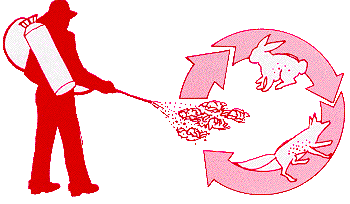
Do your part to aid the environment. Protect your surroundings by practicing
proper pesticide use.
Back to Top